Grandfather Foreign Exchange Report
|
Grandfather Economic Report series
Home
& Contents | Summary | Feedback | What's
New | Link Index | Eye-opener
| Must See |
Grandfather Foreign Exchange Report
|
< Value of the U.S. dollar is down up to 82% - trend still declining >
This is the International Exchange Rate Report, a chapter of the Grandfather Economic Report series which compares economic and education trends facing our young, to past generations - - and gives graphic evidence that a strong dollar (not a weak dollar) and positive trade balances are in the best interest of families and their children.
This is the Summary Page of the Foreign Exchange Report
(the full report and graphics are from a link at bottom of this page)
QUESTIONS Should our children be proud that theirs is the largest creditor nation on Earth, while earning a hard currency with continually rising international buying power - - as it was when we were their age? Or, be proud of today's reality > > being the largest debtor nation on earth and earning a weak currency, with a long-term erosion in international buying power. Why has nearly every U.S. treasury secretary said to the American people: "A Strong Dollar is in the Interest of the U.S.", when in fact the dollar's international value continues to plummet against other currencies, year after year? Why do they say that when results are 100% out of phase with what they say? Do they think a strong dollar can result from rhetoric-alone instead of doing what is required to make it strong? Based on exploding trade deficits and debts and a declining manufacturing base, is the US dollar threatened to repeat past long-term declines? And looking forward, does the new European currency (the EURO), issued in Jan. 2002, pose a future threat to the dollar, and therefore to relative U.S. living standards and national security? Does the Yen also threaten, considering Japan's positive trade balances and strong internal savings vs. horrendous negative balances in the U.S.? What about China? |
The following chart shows the dramatic negative trends of the U.S dollar vs. currencies of several industrial trading partners - - a drop up to 82% in the dollar's international power. Note the U.S. officially went off the gold standard in 1971.
During these 41 years Americans became more consumptive spending-addicted, more debt-dependent and less savings-oriented and manufacturing-based than ever before in history. Major trade imbalances resulted, causing the international value of our currency to decline dramatically over the period.
The end of this down-trend is not in sight.
Here's the chart of long-term trends of the international rate of exchange of the U.S. dollar.
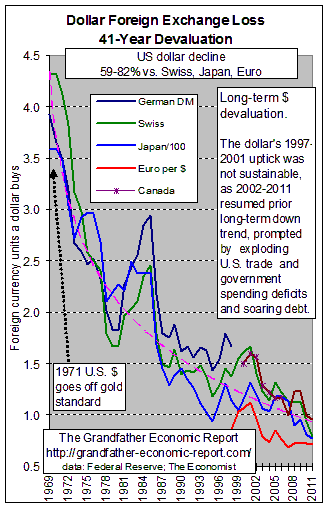 Many
times during this period U.S. government officials allowed (even encouraged) actions
helping cause this situation, believing a weak dollar would turn trade deficits into
surpluses by boosting exports. They were actually engaged in competitive devaluation of
the currency we pay our workers. They were wrong: exports languished and imports soared,
and negative trade balances exploded as the U.S. manufacturing base faltered. De-valuing
the dollar alone does not resolve negative trade balances, as proven by history.
Many
times during this period U.S. government officials allowed (even encouraged) actions
helping cause this situation, believing a weak dollar would turn trade deficits into
surpluses by boosting exports. They were actually engaged in competitive devaluation of
the currency we pay our workers. They were wrong: exports languished and imports soared,
and negative trade balances exploded as the U.S. manufacturing base faltered. De-valuing
the dollar alone does not resolve negative trade balances, as proven by history.
Looking for a way out from collapsing trade balances, starting in 1997 Treasury officials voiced (vocal, only) support for a strong dollar and played a public relations game touting the US was in a 'New Era', which, together with uncertainty concerning changes in the European Union and its new currency (the Euro) and Asian currencies, helped the dollar recover a slight bit from years of decline (see chart). But history proves that just a couple years upside does not assure future strength and buying power stability, unless negative trade balances are reversed. The chart for 2002 indicates the recent up-tick was but temporary.
In fact, past depreciation of the dollar actually resulted in larger negative trade balances. The dollar's slight up-tick in 1997-2001 occurred despite U.S. trade deficits soaring to new all-time unsustainable records each year - - as shown in the International Trade Report graphics - - and despite soaring ratios of private sector debt of the household, business and financial sectors which encouraged over-consumption of imports instead of internal savings and production.
Note the dollar's 2002-2010 down-tick vs. the Yen, Canadian Dollar, and Swiss Franc, and the strengthening of the Euro after its official launch January 2002. Is this the start of a renewed slide of the dollar's buying power - - returning to the past long-term downward trend shown in the chart, plus perhaps threatening the prior dominance of its world reserve status? Note, also, the more recent decline indicates an even sharper reduction in the dollar's value - - and gives every appearance (per this chart) of resuming its long-term decline.
This shows the U.S. must do more than 'talk-up' the dollar and play change the measurement criteria with statistical wizardry for GDP, inflation, productivity and reliable corporate earnings to make the economy appear better than it is. America must reverse its trade imbalances, reduce soaring private sector debt ratios, reverse its manufacturing decline, and reverse negative private savings ratios strong to the upside. So far there is no evidence of such.
By the way: the period of declining dollar values shown in the graphic's first 25 years was the same period of stagnant and falling U.S. median family incomes (adjusted for inflation) and savings, as reported in the Grandfather Family Income Report, declining education productivity & quality, declining productivity, soaring social spending and soaring government debt ratios.
And, this period was preceded by government spending growing much faster than the total economy, steadily reducing the share of the private sector, as government mandated regulatory cost ratios climbed. Additionally, state & local governments continue to grow their employee head-counts at rates faster than general population growth. America became less strong and less competitive.
Warning
In its August 2001 annual assessment of the world's largest economy, the International Monetary Fund (IMF) said "the yawning current account deficit raised the risk of a sharp depreciation in the U.S. currency." The warning was again issued in early 2007 and in 2010. The above chart shows the result.
so - - what happened in 2001 to 2008?
Answer: a sharp depreciation of the U.S. currency.
The US dollar declined 58% vs. the Euro 2001-2008, and also down against many others incl. 39% vs. the Canadian dollar and 45% vs. the Swiss Franc. Regardless of the impact of U.S. stock, bond, real estate or commodity markets in the end most Americans think of their assets in terms of dollars, yet few recognize that a huge international depreciation (write-down) of those assets and the international value of their earnings is again in progress - - and there is little most know what to do to protect themselves. Just think, for every 100 thousand dollars of a citizen's assets the international buying power dropped $58,000 since 2001 vs. the Euro. Not only does that wipe-out incentive for foreigners to invest in dollar assets to help finance America's savings-short, deficit economy, it negatively impacts the store of value of U.S. citizen savings and effectively causes a huge decrease in the international value of U.S. wages.
In the past several years many average citizens experienced large decreases in the dollar value of their stock market assets, due to huge market declines of a bubble economy that was pumped-up by soaring debt and erroneous claims. Many more conservative citizens, who stayed away from the market pounding to protect their savings, at least came out with their assets in tack but were later horrified to witness interest earnings on their assets chopped 80%+ during 2001-2008 as the Federal Reserve, trying to promote even more debt in the debt-laden economy, forced interest rates to record low levels. On top of this comes the huge depreciation of all dollar assets in terms of its international-value, as the dollar dramatically falls.
What happened in 2006?
Answer: another sharp depreciation of the U.S. currency.
The next chart includes the trade-adjusted U.S. dollar index Dec. 2005 through Dec. 2006
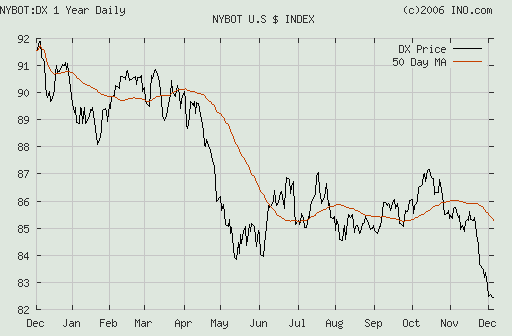
and what happened in 2007?
Answer: the sharp depreciation of the U.S. currency continues south.
The next chart includes the trade-adjusted U.S. dollar index Nov. 2006 to Nov. 2007
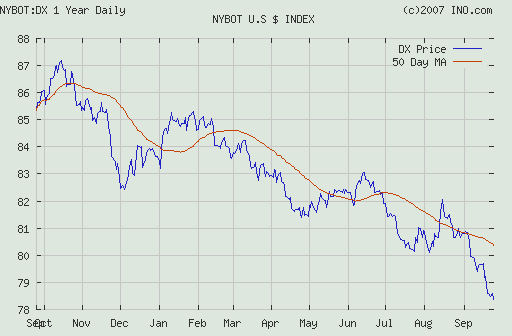
Source: http://quotes.ino.com/chart/?s=NYBOT_DX&v=d12
Not a very nice picture regarding U.S. dollar's
international purchasing power
- and, in the beginning of 2008 declined even further,
followed by a rebound at beginning of global financial crisis,
now, mid 2010 to early 2011 a sharp down-turn once again.
click here for current trend graphic
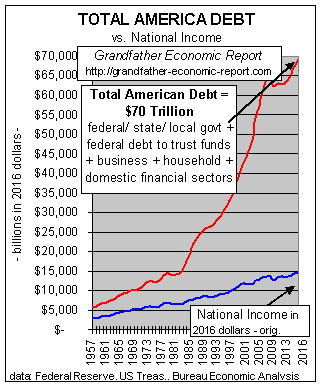 Hello to Debt
and more Debt
Hello to Debt
and more Debt
Here is a major cause for the declining international value of the U.S. dollar -
- its proof America continues to live beyond its means -
- needing more and more debt to operate its economy.
The chapter called America's Total Debt
Report charts trends showing record high debt to national income ratios in
all sectors - - also impacting the value of the dollar internationally,
as does internal devaluation of the dollar demonstrated by data graphics in the Inflation Report.
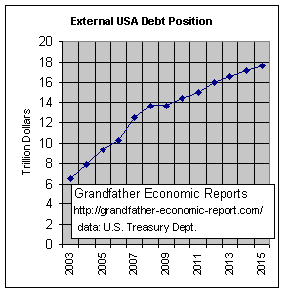 And, as shown by the left chart - - U.S.
debt owed to foreign entities has soared to nearly 15 trillion.
And, as shown by the left chart - - U.S.
debt owed to foreign entities has soared to nearly 15 trillion.
The International Trade Report includes data graphics that help tell the trade story, as America's trade deficits soared to ever higher records.
That report shows > In the 12-month period to Feb. 2008 the U.S. had a total merchandise trade deficit of $827 billion, while Japan & Germany produced a cumulative trade surplus of $377 billion ($105+$272). That's a whopping $1.2 trillion worse relative trade performance for the U.S., in JUST ONE YEAR - against two high-wage nations. And, these are not oil-related deficits, since Japan and Germany must import 100% of their oil needs, whereas the U.S. imports a smaller ratio. U.S. trade deficits go on, and on - - to the benefit of foreign entities and the detriment of U.S. savers and wage-earners, because the American economy 'refuses' to produce enough of its needs.
The long-term performance of our currency is our fault (negative trade balances driven by massive internal debts).
It should be unacceptable to pass to our young an economy which not only provides stagnant earning power and a difficult living standard in dollars, but a currency with a continued history of devaluation in its international store of value, against children of other major developed nations.
Several generations ago, the U.S. dollar was king,
and the one who earned dollars felt like a king when he traveled.
No longer!
It is clear U.S. economic 'policy' actually encourages a continual devaluation of the international value of the very currency in which its citizens earn and save - - the U.S. dollar. It is clear this 'policy' transcends both political parties. What is this policy: it is one that encourages consumption (instead of savings) beyond the earnings and beyond ability to manufacture its own goods - - meaning it encourages expanding debt and assets owed to foreign interests, and it does so by pushing extra low interest rates to encourage debt based consumption and inflation
The charts above say it all.
President Kennedy had it right regarding the dollar. What happened since then?
"The security of the dollar involves the security of us all...
We are determined to do whatever must be done in the interest of this country and,
indeed, in the interest of all to protect the dollar as a convertible currency at its
current fixed rate.We are determined to maintain the firm relationship of gold and
the dollar at the present price of $35 an ounce, and I can assure you will do just
that."
'FISCAL RESPONSIBILITY USA - MUST END ITS PAYMENTS DEFICIT', a speech by John F. Kennedy, President of the United States, delivered before the International Monetary Fund, Washington, D. C., September 30, 1963
NOW, with that U.S.
Government commitment in mind go back to the chart at the top of this page
and see what happened to the dollar exchange rate since JFK's speech
"Foreign interests have more control over the US economy than Americans, leaving the country in a state that is financially imprudent. More and more of our debt is held by foreign countries – some of which are our allies and some are not. The huge holdings of American government debt by countries such as China and Saudi Arabia could leave a powerful financial weapon in the hands of countries that may be hostile to US corporate and diplomatic interests.” See the trend graphics of this soaring international debt. David Walker, the US comptroller general. 23 July 2007. http://business.timesonline.co.uk/tol/business/markets/united_states/article2120735.ece
See the trend data graphics of this scary, soaring international debt.
If you would like to see a simple comparison of the trends of the dollar's international value vs. the trend of the dollar's internal purchasing power, see >
The U.S. Dollar's Two-Step - - article > Devaluation of the dollar - - internally and internationally. Should we expect differently than the past? We can always hope our dollar-based savings and assets will be under-pinned by a stronger dollar, both domestically and internationally, in the future than in the past. History, with such long-term negative trends in place, is a powerful teacher - - requiring uncommon "bravery" to bet against, wanting to believe that this time it will be different.
CLICK THIS LINK TO THE FULL FOREIGN EXCHANGE RATE REPORT with color pictures
Copyright © 1997-2011 Michael W. Hodges. The Grandfather Economic Report series is the intellectual property of its author; all rights reserved under Copyright Conventions. Permission to redistribute all or part of this series for non commercial purposes is granted by the author, provided the associated web page address is included and full credit given to the Grandfather Economic Report and the author, Michael Hodges. Notice appreciated via email.